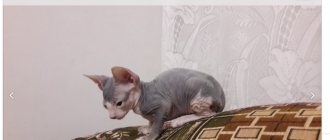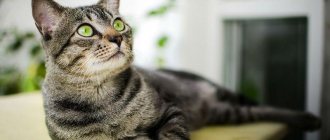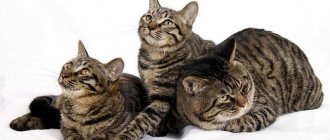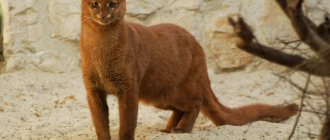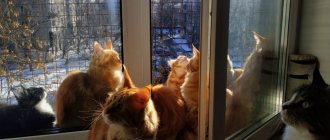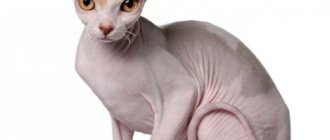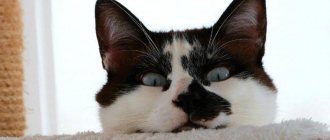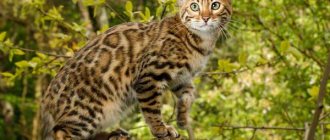Appearance of Oriental cats
Short-haired cats: list of popular breeds
The Georgian cat has a long body. Graceful lines create the image of an aristocratic animal. The tail is long. The head is large, triangular in shape. There is no smooth transition from the forehead to the nose. The cat's profile is even. The eyes are large, close-set, almond-shaped. Eye color is related to coat color.
Attention! Strabismus is considered a pathology of this breed.
The nose is big. There is no depression on the bridge of the nose. The kitten may have a slight indentation, but it will disappear over time.
The ears occupy a sufficient area at the base, are large and widely spaced.
The length of the Oriental's limbs is above average. The bones are thin but strong. Oval shaped paws.
The coat is quite short, silky, and not prone to shedding.
Where did the Orientals come from?
Asian tabby
The difference between this breed lies in 3 components of coat color: the main background, the dark pattern and the haze. They are found in marbled and spotted variations. The characteristic spotting is expressed by dark spots and stripes. A friendly, affectionate pet will be a great friend for children. These cats are smart, easily follow the simplest commands, and very rarely scratch. They get along well with other animals in the house.
Short-haired breed. It has a light undercoat, but the coat itself can be black, chocolate, blue and red. It is distinguished by large expressive eyes of amber or rich yellow color. The maximum weight of the breed is 7 kg. These cats cannot stand cramped spaces and loneliness. They are very peaceful, affectionate and flexible, and are able to express gratitude.
Muscular short-haired cat with erect ears. There is no undercoat. The color can be plain, striped, smoky, but the lower half of the body should be lighter than the upper. The average weight of an adult cat is 5-6 kg. Sociable, friendly animals with high intelligence will become best friends for the elderly and children. They are easy to train and get along with other animals.
Selection and worldwide recognition of the Oriental cat breed
The most expensive cats in the world and their breeds: top 10
In Britain they decided that Orientals were a selection error when breeding Siamese cats. The cats were rejected.
A cat that looks like a Georgian fell in love with some breeders who decided that the breed has the right to recognition and life. The Oriental Georgian cat was exported to America, where experts continued to work on the purity and popularization of the breed. It took more than 80 years for the breed to be recognized. Cats were recognized in 1974, but only in America. The British did not change their opinion and refused to register the breed. The breeders achieved their goal only in 1997.
Features of oriental content
The first mentions of cats of this breed are found in Thai poems of the 14th century. The animals were not known in Europe until the 19th century, since in Thailand they were considered sacred and were not exported outside the kingdom. However, in 1894, representatives of the breed were presented at the London Cat Show.
Siamese oriental cat
The first attempt to establish them as a separate breed was unsuccessful. The British did not recognize the Oriental Shorthair cat because of its similarity to its Siamese counterparts. The cats differed only in color, which was considered a defect of Siamese litter. However, fans of the new breed took the animals to America, where they continued attempts to isolate Oriental Shorthairs.
On the American continent, work was carried out to improve the breed data of Orientals. They were crossed with European representatives, Siamese and longhaired cats. Animals of various colors with long and short hair were bred. Subsequently, the long-haired Oriental cat was identified as a separate breed.
Registration of the Oriental breed in America occurred in 1974. The final standard was developed 3 years later. However, British clubs refused to recognize Orientals until 1997. In Russia, these cats are less popular than Siamese. However, the variety of colors is attracting more and more attention to these animals.
Due to the fact that the Oriental cat does not have an undercoat, it cannot be kept as a yard pet. Animals must live in the owner's home. The sleeping place should be equipped in a corner where there are no drafts. You can take cats outside. However, you should choose warm days for walking. Orientals are easy to care for. However, some rules must be followed.
Animal care
Short-haired pets do not need frequent brushing and bathing. However, in order for the fur to look attractive, it is necessary to comb the cat 2 times a week and smooth the fur with a damp cloth or rubber glove. The Oriental Longhair cat needs daily brushing.
Ears should be cleaned once a week. To do this, you need to prepare cotton swabs and an antiseptic solution. You need to clean the inside of your ear. During the procedure, you should avoid strong pressure and penetration of the stick into the auricle. If cleaning is done correctly and regularly, the pet does not show anxiety.
From an early age, it is necessary to accustom your cat to brushing its teeth. Every 3 days you need to clean off plaque with a soft brush, and use special cleansing pastes once a week. To prevent the formation of tartar, you can give your pet hard meat pads.
Natural mucus rarely accumulates in the eyes of cats. However, you should wipe the corners of your eyes with a damp cotton cloth several times a week. You can't put pressure on your eyeballs. The direction of movement during the procedure should be from the corner of the eye to the bridge of the nose and down.
Nails are trimmed at least once a month. For the procedure, you need to purchase a special nail clipper. Only the sharp ends (approximately 2 mm) should be trimmed, as deep trimming can damage the paw and cause bleeding. If the animal behaves restlessly, cut off 2-3 claws over several days.
Restriction of physical activity is unacceptable for an Oriental cat. Your pet needs active games, so for its comfort you need to purchase various toys: balls, hanging devices, bows. To prevent the cat from jumping on furniture and window sills, you should install a special play complex or independently build shelves for it, located at different heights.
Once a day you can walk your oriental cat outside. For walks, you need to wear a harness with a long leash. You should also purchase clothing for your pet for cold weather. You should avoid walking in severe frosts.
Nuances of feeding
Representatives of the breed are rare animals that tolerate whole cow's milk well. However, dairy products should not form the basis of your pet's diet. Orientals are prone to overeating, so experts recommend being careful when choosing their diet. The daily calorie content of an adult animal should be 250–300 kcal.
Since it is difficult to calculate the calorie content of foods when feeding them naturally, Oriental cats are most often fed prepared foods. For this breed, premium and higher class products are chosen. To provide the cat with the necessary amount of fat, 1-2 grams of high-quality butter are added to the food.
If the owner prefers natural nutrition, the basis of the daily diet should be lean meats. The following rules for feeding natural products should be observed:
- Minimize the consumption of cereals. The pet is given buckwheat and oatmeal porridge mixed with finely chopped meat.
- Once a week, give deboned lean fish and a boiled quail egg.
- Add fresh and boiled vegetables to meat dishes daily.
- Feed your cat fermented milk products several times a week.
- Exclude from the diet food from the master's table, fatty, salty, sweet, flour and spicy dishes.
- Transfer the animal from ready-made food to natural food gradually. However, you should not practice a mixed diet, since this leads to an excess of some microelements and a deficiency of others.
- Fortify food with vitamin and mineral supplements. A suitable complex is selected together with a veterinarian.
You can determine whether the diet has been chosen correctly by the appearance of the coat. An animal that receives all the necessary substances has shiny fur and does not fall out in large quantities. Experts pay attention to the choice of place for feeding. The cat should eat in a place where it is not distracted by foreign objects or noises.
Description of an oriental cat breed similar to Georgians
If the owner is prone to irritability, then the constant vocal accompaniment that the Oriental kitten will produce may cause discontent.
The Oriental cat is one of the most active representatives of the domestic cat world. He is constantly doing something, hunting for sunbeams, for legs, for anything.
An Oriental Georgian will strive to jump on a wall, on a flower in a pot. These cats are very restless. They are literally like children under two years old - you need to keep an eye on them.
Oriental habits
Recommendations for choosing a kitten
You need to purchase an Oriental cat kitten from specialized nurseries. When choosing a breeder, you should read reviews and photographs of animals from this nursery. When choosing a kitten, you must follow the recommendations of experts:
- Do not buy an animal under 3 months old. Experienced breeders do not allow purebred pets to be sold until they have received all the necessary vaccinations.
- Pay attention to the conditions in which cats are kept. Conscientious sellers do not put Oriental breed kittens in cages. If babies are kept indoors, they do not adapt well to their new home. Some cats develop psychological disorders due to prolonged exposure to confined spaces.
- Study the external condition and behavior of the kitten. Healthy animals have clear eyes, large clean triangular ears, and soft, shiny fur. The Oriental Longhair has noticeably longer hair. From an early age, Orientals are very active. They try to get out of the basket or constantly look over its sides.
- Review the documents confirming the pedigree of the parents.
How much a cat will cost depends on its color and compliance with the breed standard. If there are minor defects, the cost of the baby will be reduced. The average price of a kitten is 30–40 thousand rubles.
Sphynx cats: reviews from owners
Reviews from owners say that sphinxes are incredibly cute. If the future owner dreams of love at first sight, or rather at the first touch, then this velvet animal is just the thing.
Cats are very playful and affectionate. They are very attached to the owner and to everyone in the house. They show their feelings very clearly. They love to purr and sing loudly. They are very afraid to be left alone, so breeders recommend spending as much time as possible with the cat. It is important for a pet to have its owner nearby.
One of the disadvantages that all owners talk about is the toilet. After the cat has done its business, hygiene procedures will need to be performed. Sphinxes do not really like to lick themselves, which is a plus on the one hand, and a minus on the other. Plus, they don’t put anything dirty in their mouths. The downside is that the owner will have to be a cat mother and constantly care for the pet.
Important! One strange feature of these cats is their lack of satiety. Eating is their middle name. They love fruit very much.
Due to the lack of wool, they freeze. The owners advise equipping a house or a warm bed for the sphinx. This method of creating comfort for a cat will protect it from hypothermia and illness. If they are cold, they will not be silent. The cat will meow loudly and come running to warm itself.
Sphynx is a hypoallergenic breed
Pros and cons of the oriental Georgian cat
Flaws:
- stubbornly achieve their goal, will very persistently demand attention, encourage the owner to play together, which can deprive you of peace and quiet;
- representatives of the breed are willful, they are difficult to train and manipulate by humans;
- the high cost of pet food, the need to carefully monitor the pet’s diet;
- high cost of a kitten (about 20-30 thousand rubles);
- the likelihood of genetic diseases.
Positive sides:
- are distinguished by devotion, care, and attention to the owner;
- get along well with other pets, they are not inclined to show aggression;
- very beautiful, non-standard, memorable appearance;
- fairly simple care that does not require long procedures;
- a very active and playful cat breed;
- Oriental cats get along well with small children.
Remember that with proper care, love and care, you will find in the Oriental a faithful and devoted friend, a true family member!
Which cats are suitable for allergy sufferers?
Surprisingly, Siberian fluffy cats are perfect for allergy sufferers. Experts have not found a scientific explanation, but out of 100% of allergy sufferers, 75% of Siberians do not cause allergies.
The Devon Rex is also a hypoallergenic cat breed. The fur of these cats is very short and strong. Cats are not subject to shedding at all.
The Don Sphynx is one of the most hypoallergenic among the cat family. By the way, if something hurts in the owner’s body, the Don cat will come running to treat it.
And the most hypoallergenic cat breed is the Canadian Sphynx. Pets of this breed have extremely poor secretion of skin secretions, which can cause an allergic reaction.
American Bobtail (Yankee Bob)
The main feature is a short movable tail (from 2.5 to 7.5 cm). These cats have a long, muscular body, low paws and a wide, almost square muzzle. There are short-haired and semi-long-haired individuals. The color can be any, the most common being agouti. Weight – 3-9 kg. Smart cat, loves big companies and active games.
Large breed of cats, weighing up to 15 kg. The body is muscular with an arched back. The tail is short, consisting of one or more knots. The coat is of medium length with abundant guard hair. The breed is characterized by intelligence and tact; they do not like to be held, but enjoy chasing toys.
Short-tailed, color-point cat with short mink hair. The body is of medium size with proportional parts, the length of the tail does not exceed a third of the body. The ears are small, straight, and the eyes are predominantly blue. They are very curious and always try to be close to their owner.
They are distinguished by dog-like behavior, they can walk on a leash, bring toys in their teeth, and in case of danger they would rather bite than scratch.
The breed is medium-sized, slender with an elongated body and physically developed muscles, the limbs are long and strong. The tail is short, vertical, about 7 cm long, and may or may not be movable. The head is triangular with neat curves and large eyes. The coat is short and dense, without undercoat, most often tortoiseshell and white. Very smart and active, they do not like to be left alone. Ideal for living in city apartments.
There are more than 250 breeds of cats in the world: hairless and fluffy, wayward and friendly, affectionate and freedom-loving. But there is one thing that unites them all: they are incredibly beautiful. Anyone who wants to make a meowing friend can adopt a kitten from a shelter, or buy one from an elite nursery.
We suggest you familiarize yourself with: Pecilia maintenance care reproduction feeding
How much do the rarest cat breeds cost? Find out prices for the most exotic representatives of the cat world.
Ashera Ashera is the most exotic domestic cat in the world. It was created by crossing a domestic cat and an Asian leopard cat. According to the creators of the breed, this cat is hypoallergenic, but there is controversy about this statement. You can become the proud owner of an Ashera for $22,000-$100,000.
Norwegian Forest Cat The ancestors of this cat were bred by the Vikings 2000 years ago. Cute and fluffy, this cat can withstand severe cold and is an excellent hunter. The price of a kitten varies from $600 to $3000.
Himalayan cat This breed is very similar to the Persian, but differs in blue eyes and color point coloring (light body with a dark muzzle, paws, ears and tail). This breed was developed in 1950 in the USA. Himalayans are affectionate, obedient and friendly cats with a calm nature. A kitten of this breed will cost $500-1300.
Scottish Fold The calling card of this breed is its cute ears that do not stick out upward, like those of ordinary cats, but hang down. This unusual detail of their appearance is a consequence of a gene mutation. These are smart cats that get along with everyone in the family and are never averse to playing. Another distinctive feature of this breed is that they can stand on their hind legs and look at what interests them. A kitten costs from $200 to $1,500.
Peterbald The Peterbald, or St. Petersburg Sphynx, was bred in Russia in 1994. These elegant cats have a slender body, a long head shape and large, set-back ears. The body may be bald or covered with down. Cats have an affectionate and sociable character and are easy to train. Such a kitten will cost $400-1200.
Egyptian Mau The appearance of these cats has changed little in 3000 years - since the times of Ancient Egypt. The spotted color of this breed appears not only on the coat, but also on the skin. To become the owner of an ancient Egyptian cat, you need to spend $500-1500.
Maine Coon This is one of the largest cat breeds. Representatives of this breed can weigh from 5 to 15 kg, and the body length of an adult Maine Coon can reach 1.23 m. But despite their formidable appearance, these are affectionate, gentle and playful animals. The price of a giant kitten varies between $600-1500.
LaPerm This is one of the most unusual breeds, which appeared in 1980 in the USA. In addition to their curly hair, cats of this breed have another feature: they are hypoallergenic, so they are perfect for families with allergies. A kitten of this breed costs $200-2000.
Russian Blue This is one of the most popular shorthaired cats. It became known outside Russia in 1893. As legend has it, this cat brings good luck to the house. You can buy a Russian talisman for $400-2000.
Serengeti This breed was developed in 1994 in California. She belongs to large cats: the weight of an adult Serengeti is 8-12 kg. They have a strong build, large ears, spotted coloration and very long legs. You can buy such a cat for $600-2000.
Elf This young cat breed was bred in the USA in 2006. Elves are very friendly, intelligent, mischievous, sociable, inquisitive and loyal creatures. Those wishing to purchase such a unique pet will have to pay a considerable amount - 2000 US dollars.
Toyger This large cat breed resembles a tiger in color, which is why it got its name. The creator of the breed claims that the Toyger was bred to inspire people to care about the conservation of tigers in the wild. You can get inspired to save tigers for $500-3000.
American Curl This breed was developed in California in 1981. Newborn kittens are difficult to distinguish from ordinary cats, but by the 10th day of life their ears curl back like small horns. This feature touches hundreds of thousands of people around the world. You can join the curl lovers for $1000-3000.
Bengal This breed was developed by crossing an Asian leopard cat with a domestic cat. These cats love to swim, and despite their impressive size (4-8 kg), they often climb onto their owner’s shoulders. You can buy a mini leopard for $1000-4000.
Safari This rare breed was created by crossing an ordinary domestic cat and the South American wild cat Geoffroy. The first representatives of the breed were bred in the United States in the 1970s to study leukemia. The average weight of an adult cat is 11 kg. You can become the owner of a domestic predator for $4000-8000.
Kao-mani The earliest mention of this breed is in the Tamra Maew, or Cat Book of Poems (1350-1767). In ancient Siam, kao-mani lived only in royal families and were considered a symbol of good luck, longevity and wealth. You can buy an oriental talisman for $7,000-$11,000.
Chausie This one of the rarest breeds of cats appeared thanks to the crossing of a domestic cat and a swamp lynx. These are very sociable animals that find loneliness difficult. Such cats will be happy with any company: a person, another cat or even a dog. The cost of a kitten varies from $8,000 to $10,000.
Caracal The caracal is endangered. Several years ago, the caracal moved from the category of wild predators to a number of exclusive and expensive pets. Therefore, by purchasing a kitten for $7,000-$10,000, you can help preserve this unique species.
Savannah This breed was born by crossing an African Serval and a domestic cat. These are the largest cats: the weight of an adult is on average 15 kg, and the height is 60 cm. Savannahs are known for their high level of intelligence, calm character, curiosity and activity. They love water treatments, walks in the fresh air and active games. To get such a cat, you need to have a large space for her to play and $4000-22,000. The original was taken from
Fluffy and hairless, affectionate and capricious, fidgety and lazy – all these are our favorite purring pets. There are dozens of cat breeds in the world, each with unique characteristics. If you are lucky enough to become the owner of a kitten with an impressive pedigree, it is better to know in advance how to care for it, what to feed it and what tricks to expect.
How to care for the skin of hairless cats
The main condition for caring for a cat is control. The skin is very delicate and the sun can burn the animal. The owner needs to ensure that the kitty does not overuse sunbathing.
In addition, it is recommended to bathe your Sphynx weekly. To prevent bathing from causing aggression, you will need to get used to it from childhood.
Important! Once every two days you need to wipe your pet with baby wipes.
Comedo clusters may form on the ridge and near the tail. They cannot be squeezed out. This can cause inflammation on the animal's skin. To reduce the incidence of comedones, you need careful care of your cat's skin.
Thus, Oriental cats are popular pets. They are often called Georgian cats because of their unique appearance. However, they have nothing in common with this nationality.
Health and life expectancy
The average life expectancy of Oriental cats is 15 years. However, throughout their lives they may suffer from diseases characteristic of most Oriental breed cats. These include:
- Cardiac pathologies. The risk of developing diseases increases in cats with limited physical activity and excess weight.
- Inflammatory processes in the oral cavity. The most common problem is gingivitis. Regular dental care helps minimize the likelihood of developing pathologies.
- Liver diseases. Most often it is a hereditary or congenital problem.
- Urolithiasis or kidney failure. Develops in neutered and aging pets due to improper nutrition.
- Retinal atrophy. It is detected in both adult cats and kittens up to one year old. It is possible to diagnose pathology only with the help of special equipment.
- Strabismus. A congenital defect that is noticeable upon visual examination.
- Flat chest syndrome. Identified immediately after birth. Often leads to death at a young age.
Orientals are also susceptible to all feline infectious pathologies, so they need to be vaccinated in a timely manner. The first vaccination is given to kittens 2–3 months after birth. Babies are vaccinated again after a few weeks. Revaccination is required annually. The following measures can help keep your pet healthy:
- proper feeding;
- limiting contact with street animals;
- regular checkups with a veterinarian;
- timely treatment against helminths, fleas and ticks;
- protection from drafts and cold.
Turkish Angora
Has high-set large ears. The wool is soft, pleasant to the touch, without noticeable undercoat. Any color is acceptable. The maximum weight of an adult is 4.5 kg. Cats have the ability to parody their owner's facial expressions and some vowel sounds. They are very cheerful and love to play with water and rustling objects. They easily learn commands and rules. They prefer walks in the fresh air.
An elegant cat with a narrow muzzle, long hair and a bushy tail. The nose is small, the eyes are large, oval in shape, the ears are large and set high. Almost any color is acceptable, but white cats are popular. Angoras are very active and intelligent. While playing, it can create a mess in the house.
The cat is large in size, with a predominant white color. They must have symmetrical red spots below the ears and red rings on the tail. Acceptable eye colors: copper, blue or different. The paw pads and nose are always pink. The coat is long, soft and silky. The color is red with white, cream or tortoiseshell. Trainable, energetic and friendly animals.
Caring for Oriental cats with a nose like a Georgian
What to feed
When choosing a brand of dry food, give preference to “super premium” lines; they will replenish the balance of essential vitamins and microelements, making the diet balanced and the pet’s appearance well-groomed. Read more about feeding.
It is recommended to give preference to feed from the following manufacturers:
- Royal Canin labeled healthy food,
- Hills for active breed cats.
Rules when creating a menu for a pet:
- for coat care, it is recommended to give Orientals 2 drops of melted butter as an additive to their main food;
- foods high in fiber should be excluded;
- the presence of fats in food is necessary (about 20% of the total diet), the amount of carbohydrates can be reduced (2-3%), proteins make up up to 50%;
- from meat you need to give beef, chicken, turkey, rabbit from a trusted supplier and of high quality;
- boiled sea fish, strictly without bones, 1-2 times every 7-10 days;
- exclude dairy products from the menu of an adult cat, this leads to diarrhea.
You should always make sure there is fresh water in your cat's bowl!
The Oriental's feeding schedule depends on its age:
- Kittens are fed 5-6 times a day;
- Growing individuals should be given food 3-4 times (9-12 months);
- adult cats are fed more often 2-3 times depending on the amount of food and menu items.
How to care for claws, eyes and other body parts
The Georgian cat, in accordance with the standard, has short hair, without undercoat, which does not require special care, you just need to maintain a balanced diet, do not give the cat harmful foods or cheap dry food.
It is not recommended to bathe Orientals:
- firstly, they take excellent care of their fur;
- secondly, they do not like water treatments; contact with water can be stressful for the pet.
To care for your claws, you need to take the following measures:
- be sure to purchase a scratching post and teach your Oriental to use it from a young age, otherwise overgrown claws will become a problem not only for the cat, but also for yours;
- If the claws continue to grow, you should carefully cut off the long part of the claw in the place where there are no blood vessels using special scissors.
The outside of the ear must be systematically inspected and cleaned with soft cotton wool ear sticks. The procedure is carried out once every 10-14 days.
If you notice dark-colored discharge, contact your veterinarian immediately!
Representatives of the breed are very sensitive and prone to gum inflammation, so caring for the cat’s mouth should be carried out regularly from a young age. To do this, teeth are brushed 2 times a week using a children's toothbrush and a special paste.
If inflammatory processes occur on the gums, you should immediately contact your veterinarian!
Bowls should be kept in exemplary cleanliness, do not forget to wash them as often as possible.
At what age should vaccinations be given?
Vaccination of Orientals and Siamese cats is carried out according to the same schedule:
- 9 weeks;
- 12 weeks;
- 15 weeks;
- 6 months;
- 12 months.
Before vaccination, it is necessary to examine the general condition of the animal, undergo a preparation procedure, including timely distribution of anti-worm medications (carried out in accordance with the veterinarian’s recommendation 7-14 days in advance).
Every year, Oriental cats must receive the following vaccinations against:
- panleukopenia;
- calicivirus;
- rhinotracheitis;
- leukemia virus;
- rabies.
What pet diseases can an owner encounter?
The average lifespan of a cat similar to a Georgian is from 12 to 15-16 years. The cat’s health depends on quality care, because many diseases can be prevented at an early stage if you pay due attention to your pet.
The Oriental cat has fairly good health, but is prone to inflammation of the gums, the tissues that surround the teeth.
Prevention of gingivitis and periodontitis is mandatory; for this you should follow hygiene procedures and regularly visit a veterinarian who examines the animal!
Often representatives of the breed have common diseases with Siamese cats: heart problems, kidney disease, manifestations of liver failure.
Remember, an annual examination by a veterinarian is mandatory for cats 7 years of age and older!
British Longhair
Balinese cat
These cats never grow to be giants; they are usually small or very small. The Balinese were born in Thailand, but this does not prevent them from communicating well with the whole world. You still have to look for such an open cat, striving to love and be loved!
Cymric
The Cymric cat comes from Canada. Some consider it a long-haired version of the Manx, but Canadians are sure that they have their own breed and it has the right to exist! Stocky, muscular and round are the main characteristics of the Cymric breed. They are also trainable and easy to bathe, as they simply adore water and water procedures.
Kurilian Bobtail
This is the Russian version of the short-tailed cat. The pom-pom tail, frost resistance and canine habits are the unofficial standard of the Kuril Bobtail breed. The length of the tail is different for each representative of the breed, traditionally varying from 2 to 8 vertebrae. The absence of a tail at all is a disqualifying sign.
LaPerm
Again a rex cat breed with wavy hair. Laperm is both American blood and oriental spices. In addition to curly hair, breeders note the silence of laperms. These are not the cats that wake you up in the morning with deep cries, but the ones that pull you out of your sleep with affectionate rubbing of the owner.
Munchkin
The Ulybaka cat is a munchkin cat. The length of its knife is three times shorter than the length of its body. A dachshund cat sometimes behaves like a kangaroo cat - it sits on its short hind legs and props up its body with a strong tail. Munchkins arrived in our open spaces only in 2001 and so far munchkins are not particularly popular.
Himalayas
The Himalayan Colorpoint is very similar to the Persian cat, but the latter is never colorpointed. Another difference from the Persian cat is that the Himalayan cat is more active and playful. Long-haired cats get bored decorating the world with themselves and they are happy to run after a sunbeam.
Persian cat
Oh, the oldest and most popular! Yes, the creature, descended from the cat Scheherizade, must be treated with special respect. The snub-nosed cat lifts its nose for any reason and does not really like fuss around itself. According to the standard, there are about 100 varieties of Persian cat colors, but all these cats are similar in type of build - they are strong and massive.
Cats have medium-length fur, but appear fluffy due to their thick undercoat and short legs. The muzzle is large and massive with pronounced cheeks and large round eyes. There are many color variations. The color of the eyes should match the shade of the fur coat. Character is kind, sociable. Cats are obedient and calmly experience separation from their owner.
The calling card of the breed is its short plush coat and muzzle with massive cheeks and round orange eyes. Average weight – 5-8 kg. Creatures with character, that is, you won’t be able to squeeze them until they allow it. The British are neat and obedient, they love order. They remain active throughout their lives. They calmly tolerate separation from their owner.
These are representatives of a semi-wild breed, the ancestors of which are considered to be the bobtail from Japan. These pets are called lynx cats, because in appearance they are very similar to them, and, in addition, they are adapted for life in a wild, harsh environment. Life on the Kuril Islands made the cats large, hardy and fearless, and crossing them with the Siberian cat had a fruitful effect on their character.
- a large cat with a short tail and semi-long, dense hair, the claws of these cats do not retract, they love water very much. They become very attached to their owner and can even protect him, driving away strangers.
This is the abbreviated name for these cats; they have the chic Persian coat and the original color of the Siamese. There are many legends and tales wandering around the breed and they are called “sacred”. It is difficult to say what is true and what is fiction, however, the Burmese are truly distinguished by their “holy” character.
They are playful, but not dirty, active, but in moderation. They do not impose their communication and agree to wait until the owner has time to communicate. The Burmese cat gets along with children, but does not like excessive noise and tense environments.
They are called Siberians with Siamese sophistication; cats and cats of this breed are beautiful, large and very colorful. But this is by no means a merit of the efforts of the breeders, but the result of an accidental love between a Siberian cat and a cat with a Siamese color (it is not known for sure whether she was Siamese or Himalayan).
It is long-lived, its coat does not cause allergies and does not require painstaking care. She has a certain charisma - she loves to show off, but she is distrustful of strangers. Adapts perfectly to new conditions and loves his family.
Once upon a time, this large, colorful animal with long luxurious hair lived in the Norwegian forests. Naturally, this determined his hunting qualities and endurance, but selection work turned the cat into a cute domestic creature that retained high intelligence and beautiful appearance.
Suitable for home keeping, she is very balanced and calm. He loves to communicate, but sometimes he doesn’t mind being alone. Finds a common language with other pets and is good with children.
Cats of this breed are hard to miss - after all, they have an extravagant appearance - a wide muzzle with a flattened nose and the most luxurious fur. The breed has undergone a number of changes, not always positive, but today it has no flaws, and its representatives are healthy and active.
- This is an ideal companion who does not like loneliness and is not suitable for living on the street - only with a person does she feel calm and confident.
